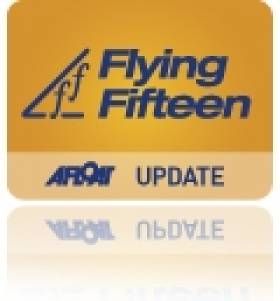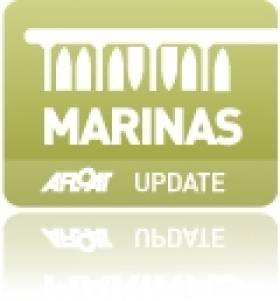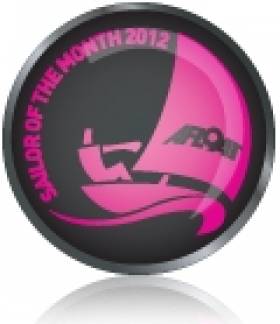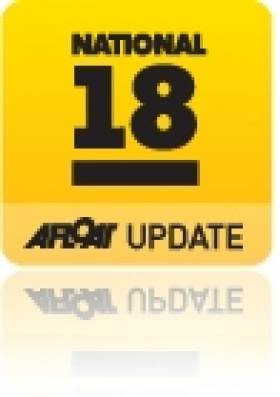Displaying items by tag: National Yacht Club
#D2D – The Round Ireland Race of 1992, like all stagings of the classic circuit, was one of mixed memories. It started in sunshine with a fair wind which carried us all the way to the Fastnet. But that wind stayed very determinedly between north and northeast, so we knew there'd be windward work round the Kerry coast.
In fact, we were on the wind until Mayo. Then it drew eventually from the southwest and there was the usual scamper across Donegal Bay and around Tory Island. Then the breeze was all over the place down the Irish Sea until we were sitting nicely, breeze off the land, aroma of the Wicklow countryside to be savoured and all that, finish line nicely in sight......and suddenly we were in a flat spot which lasted just long enough to turn a close class win into second in class by 17 minutes.
So all we really remember of the race of '92 is that sweetness of the summer evening made sour by the breeze turning off. It takes a real effort to remember that, three day earlier, we'd actually been having a right pasting off the Kerry coast. For sure, we'd known we'd have headwinds past the Blaskets. But the forecast had missed out on a deepening low to the east. So much so, in fact, that the Irish Sailing Association subsequently launched an informal enquiry into why the severe rise in the wind strength had gone largely unanticipated, as there were wholesale retirals, with much damage.
With hindsight, of course, it was there to be seen - we just didn't want to see it. We may have approached the Fastnet on a reach in sunshine. But there was a harshness to the evening, and any God's amount of warning clouds at a high level, to tell us that this wasn't going to be a straightforward bit of windward work on a summer's night. And even on a gentle summer's night, the Atlantic off Kerry can be a rumbly place. So when it came in a real stinker between north and northeast, it was boat-breaking stuff, with several ports in West Cork and Kerry acquiring their quota of retirals.

South Pacific? No, just Dingle as it can be when, as was happening in this case, most of the rest of Ireland was in heavy rain. Photo: W M Nixon
One such was the Sigma 41 Koala (Peter Cullen and Martin Crotty), which split her mainsail and did well to get to Dingle. As they put themselves together again and breathed in that Dingle air with its unmistakable sense of being in the far west and everything well with the world, they got to thinking how it would just be perfect if the race had just been to Dingle, instead of battering all the way round Ireland simply to end up back where they started from.
That's what it is with Dingle. It's one of those places that everybody thinks they're really the first ever to discover properly and understand and appreciate. It is unique, there's no doubt of that. But when you sail in there and get enveloped in its hospitable warmth, you soon think it's uniquely unique. So naturally the crew of Koala got to thinking about a sort of Round Ireland Lite, a race from the east coast finishing at Dingle.

It took Dingle to show just how effective a combined fishing/sailing port can be. It's a favoured destination for cruising boats, yet it continues to have an impressive tally of fish landings. Photo: W M Nixon
It would have been a grand thing to talk about in the convenient first stop at Flahive's before moving on to one of the excellent Dingle restaurants. And for most crews, that would have been the end of it. But the crew of Koala were made of sterner stuff. They sailed home eventually, and they just wouldn't let go of the idea of a biennial race to Dingle alternating with the round Ireland. If they were going to do it, 'twas best 'twere done soonest. So 20 years ago, in 1993, Martin Crotty on behalf of the National YC organised the first 280 mile Dun Laoghaire to Dingle Race, Peter Cullen with his jelly bean manufacturing company put up the sponsorship, and one of the best events in the Irish sailing calendar became an instant success.
It's on again next Friday, June 7th, the 11th D2D, starting before the weekend to facilitate the boats using it to get to the ICRA Nationals in Tralee Bay from June 13th. And there's an excellent line-up, an interesting balance of 22 good boats which – considering the times we live in – is a fine turnout, particularly when we look at the calibre of the boats involved.
Fond memories of the great Denis Doyle and his enthusiasm for every offshore race going are evoked by the Cork presence of Anthony and Peter O'Leary's Ker 39 Antix, briskly back to Ireland from the RORC Vice Commodore's campaigning in the English Channel series in order to race to Kerry, and make the lineup in Tralee Bay.

Anthony O'Leary (Royal Cork) and Peter O'Leary (Baltimore SC) will be racing the busy Antix in the biennial D2D next Friday. Photo: Paul Wyeth
Antix has been in the frame if not on the podium in this year's RORC racing, so her presence sets a benchmark. Defending champion in the D2D is the Galway Reflex 38, curently sailing as Discover Ireland/The Gathering. She didn't exactly cover herself in glory at last weekend's Scottish series, but then she'd all the disadvantage of being the highest rated boat in IRC 2, which made her an easy target, and the offshore scene seems to suit her better.
Certainly the Dingle Race is important to Aodhan Fitzgerald's crew as a Fastnet qualifier. With the absence of any seriously large biggy to challenge the course record set by Mick Cotter's 77ft Whisper two races ago, there's a possibility that Antix and Discover Ireland will be battling for line honours, though that is an outcome which could well be upturned by the presence of boats like the Farr 42 Wow (George Sisk RIYC), and the three Beneteau First 44.7s - Adelie (Peter Hall NYC), Legally Blonde (Cathal Drohan & Paul Egan RStGYC), and White Tiger (Anthony O'Brien, Kinsale).
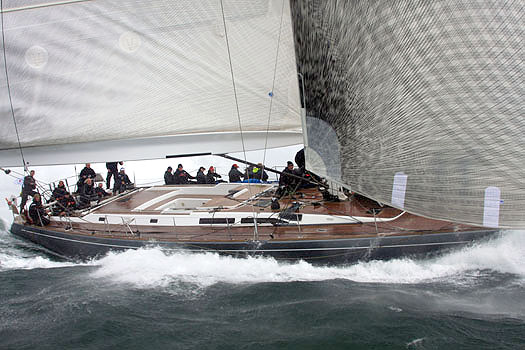
Mick Cotter's 77ft Whisper almost broke the 24-hour barrier for the record for the Dingle Race in the race of 2009. Photo: David O'Brien
Although the Irish Sea's champion J/109 Sgrech (Stephen Tudor) won't be involved, there are four of these useful all-rounders taking part, and Liam Shanahan's Ruth from the National YC was showing promising speed in the Scottish Series.
And a seriously interesting entry from further down the size scale is Paul O'Higgins' Corby 33 Rockabill V from Dun Laoghaire, which has an enviable racing record. The Corby 33 is more than sparse enough for most folk for a night or two at sea. Add in the increasing demands of the seaways as you get further west, and you have a challenging proposition which nevertheless could serve up a race win if conditions fall the right way. The smart money might just be on Rockabill V.

Paul O'Higgins' Corby 33 Rockabill V offers only the most austere comfort for offshore sailing, but in the right conditions her proven racing record might find itself augmented by the Dingle title.
National YC/Skellig Hotel Dun Laoghaire to Dingle Race 2013 Entry List
| Boat Name | Sail no | Model | Sun Division | Name | Surname | Club | IRC TCC |
|---|---|---|---|---|---|---|---|
| Antix | IRL 3939 | Ker 39 | Racing | Anthony / Peter | O'Leary | BSC/ RCYC | 1.136 |
| Joker II | IRL 1206 | J109 | Racing | John | Maybury | RIYC | 1.017 |
| Blue Eyes | IRL 9849 | Elan 340 | 2-handed | Colm | Buckley | HYC | 0.983 |
| Lisador | IRL 1295 | Dehler 36 | Racing | Henry | Hogg | Garrykennedy SC | 0.958 |
| Ruth | IRL 1383 | J109 | Racing | Liam | Shanahan | NYC | 1.02 |
| Jedi | IRL 8088 | J109 | Racing | Andrew | Sarrath | RIYC | 1018 |
| Spindrift | IRL 1503 | HR34 | Cruising | David | Kelly | Waterford SC | 0.938 |
| Polished Manx | GER8666 | Sigma 33 | Racing | Kuba | Szymanski | DBYC | 0.898 |
| Discover Ireland | IRL 7386 | Reflex 38 | Racing | Adhan | Fitzgerald | GBSC | 1.055 |
| Black jack | IRL 1988 | Pocock 38 | 2-handed | Peter/ Darren | Coad/Nicholson | WHSC | 0.934 |
| Conundrum | IRL 3503 | Hanse | Cruising | Michael | Pomeroy | RStGYC | 0.968 |
| Amazing Grace | IRL1966 | Oyster 37 | Racing | Brian | O'Sullivan | TBSC | 0.931 |
| Rockabill V | IRL 3307 | Corby 33 | Racing | Paul | O'Higgins | NYC/IRIYC | 1.041 |
| Aquelina | IRL 1281 | J-122 | Racing | James S | Tyrrell | ASC | 1.084 |
| Chancer | IRL 1583 | Elan 40 | Racing | Brian | Carroll | 1.027 | |
| White Tiger | IRL 4470 | Beneteau First 44.7 | Racing | Anthony | O'Brien | KYC | 1.113 |
| Mojito | GBR9047R | J109 | Racing | Peter | Dunlop | CHPwllheli SC | 1.014 |
| Ocean Tango | GBR6848T | Dehler34 | 2-Handed | Robert | Floate | DMYC/ WSC | 0.928 |
| Legally Blonde | IRL 3175 | Beneteau First 44.7 | Racing | Cathal/Paul | Drohan/Egan | RStGYC | 0.952 |
| Lulla Belle | IRL 3607 | Beneteau First 36.7 | 2-Handed | Liam/Brian | Coyne/Flahive | NYC | 1.001 |
| Wow | IRL 4208 | Farr42 | Racing | George | Sisk | RIYC | 1.144 |
| Adelie | IRL 9631 | Beneteau First 44.7 | Racing | Peter | Hall | NYC | 1.003 |
Comment on this story?
We'd like to hear from you! Leave a message in the box below or email William Nixon directly on [email protected]
WM Nixon's Saturday Sailing blog appears every Saturday on Afloat.ie
Follow us on twitter @afloatmagazine and on our Afloat facebook page
The Sailing Legacy of John Breslin Kearney
#irishmaritimehistory – It was a life which would have been remarkable by any standards, in any place, at any time. But in the Dublin of its era, this was a life of astonishing achievement against all the odds, in a rigidly structured society made even more conservative by a time of global unrest and national upheaval.
John Breslin Kearney (1879-1967) was born of a longshore family in the heart of Ringsend in Dublin, the eldest of four sons in a small house in Thorncastle Street. The crowded old houses backed onto the foreshore along the River Dodder in a relationship with the muddy inlet which was so intimate that at times of exceptional tidal surges, any ground floor rooms were at risk of flooding.
But at four of the houses, it enabled the back yards to be extended to become the boatyards of Foley, Murphy, Kearney and Smith. Other houses on Thorncastle Street provided space for riverside sail lofts, marine blacksmith workshops, traditional ropeworks, and all the other long-established specialist trades which served the needs of fishing boats, and the small vessels - rowed and sailed - with which the hobblers raced out into Dublin Bay and beyond to provide pilotage services for incoming ships. And increasingly, as Dublin acquired a growing middle class with the burgeoning wealth of the long Victorian era, the little boatyards along the Dodder also looked after the needs of the boats of the new breed of recreational summer sailors.
The young John Kearney was particularly interested in this aspect of activity at his father's boatyard, where he worked during time away from school. From an early age, he developed a natural ability as a boat and yacht designer, absorbing correspondence courses and testing his skills from 1897 onwards, when he designed and built his first 15ft sailing dinghy, aged just 18.
He was apprenticed in boat-building to Dublin Port & Docks across the river, qualifying as a master shipwright. But his talents were such that he rose to the top in all the areas of the port which required the designing and making of specialised structures, some of them very large. So in addition to building workboats of all sizes, he played a key role in projects like the new pile lighthouse at the North Bull, for which he developed support legs threaded like giant corkscrews, and rotated into the seabed like monster coachbolts.
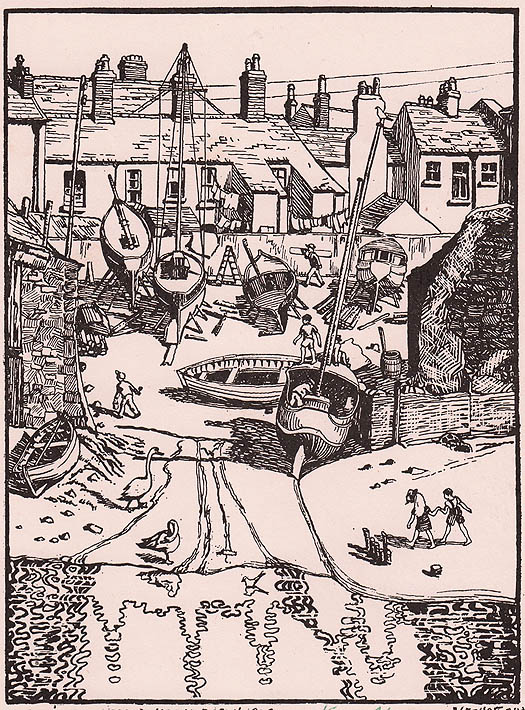
Murphy's Boatyard on the Dodder in Ringsend in the rare old times is perfectly captured in this woodcut by Harry Kernoff RHA. It was all disappeared in 1954, when the old houses of Thorncastle Street were replaced by a complex of Corporation flats of such good quality that they have recently had a major refurbishment.
He also pioneered the use of reinforced concrete for pre-fabricated harbour constructions, and when the Great War broke out in 1914, his special talents and experience were called upon to advise on quick-build ferrocement structures of all kinds. Although Ireland remained neutral as World War II broke out in 1939, the Dublin engineering firm of Smith and Pearson established a yard in Warrenpoint just across the border to build concrete barges and small ships for war work, and John Kearney was their consultant.
So far-reaching was his input into developing the infrastructure of Dublin port that when he retired in 1944, while his official title was as Superintendent of Construction Works, he was de facto the Harbour Engineer. But he couldn't be properly acknowledged as such, because he had never qualified from a third level college - it was far from universities that the Kearneys of Ringsend were reared.
However, this lack of an official title left him unfazed, for his retirement at the age of 65 meant he could concentrate full-time on his parallel career as a yacht designer, something that was so important to him that when his gravestone was erected in Glasnevin in 1967, it simply stated: John Kearney, Yacht Designer.
He had developed his skills in this area ever since his first boat in 1897. In 1901, when he was still 21, a 17ft clinker-built canoe yawl, the Satanella which Kearney designed and built for noted Dublin Bay sailor Pat Walsh, was praised in the London yachting press. Her owner camping-cruised this little boat successfully along the great rivers of Europe before World War 1, getting there simply by sailing his canoe from Dun Laoghaire into Dublin Docks, and striking a shipping deal with whichever ship's captain was heading for a port on the desired river.
Kearney had been busy for the ensuing nine years with his growing responsibilities in Dublin Port. But in 1910 he reserved a corner of Murphy's Yard, and in the next eighteen months, working in his spare time entirely by hand with the light of oil lamps, he built his first personal dreamship, the 36ft gaff yawl Ainmara, to his own design. In this his first proper yacht, he immediately achieved the Kearney hallmark of a handsome hull which looks good from any angle, a seakindly boat which was gentle with her crew yet had that priceless ability of the good cruising yacht – she could effortlessly maintain a respectable average speed over many miles while sailing the high seas in comfort.
Built in straightforward style of pitchpine planking on oak, Ainmara was highly regarded, and though the world was at war for four of the ten years John Kearney owned her, when he could sail his preferred cruising ground was Scotland. She was no slouch on the race course either. Her skipper became a member of Howth Sailing Club in 1920, and HSC's annual Lambay Race became a Kearney speciality, his first recorded overall win being in 1921 when, in a breezy race, Ainmara won the cruisers by one-and-a-half minutes.
Despite the turmoils of Ireland's War of Independence and Civil War, in the early 1920s John Kearney's position with the Port & Docks had become so secure that in 1923 he felt sufficiently confident to sell Ainmara in order to clear the way to build himself a new boat, the superb 38ft yawl Mavis, which was launched in July 1925. He was to own, cruise and race her with great success for nearly thirty years, by which time he was a pillar of the Dun Laoghaire sailing establishment – he'd a house in Monkstown, and had become Rear Commodore of the National Yacht Club, a position he held until his death in 1967.
Even with the demands of his work, and the continuing attention needed to run a yacht of the calibre of Mavis, he had found the time to design and sometimes also build other yachts of many types. What he didn't seem to have time for was simple domesticity. In later years his presence was enough to command respect, but in his vigorous younger days he could be waspish, to say the least, and a brief attempt at marriage was not a success.
Sibling relationships were also sometimes tense. Two of his brothers were boatbuilders and one of them, Jem, was almost always daggers-drawn with John. And Jem Kearney had regular battles with others, too. He was a classic Dublin character, and no stranger to salmon netting on the Liffey in circumstances of questionable legality. If one of these expeditions had been spectacularly successful, he would erupt triumphantly back into his family's little house on the East Wall Road and announce: "Pack you bags, Mrs Kearney, we're off to stay in the Gresham!" And he meant it, too. Mr & Mrs Jem Kearney of the East Wall Road became resident in the Gresham Hotel until the salmon money ran out.
So when he was building Mavis, John Kearney would only work with his brother Tom, and they were a fantastic team. But even that didn't last. One November night, working away at planking the hull, they took a break for a mug of tea at 9.30pm, and couldn't find the sugar. Each blamed the other for its absence. The row was seismic. The following night, each turned up with his own personal supply of tea, milk and sugar. And the work continued as smoothly as ever. But not one single word was exchanged between the two brothers for the remaining eight months of the project. It was years before they spoke again.
Quite what this meant when Mavis launched herself on St Stephens Day 1924 we can only guess. Like Ainmara eleven years earlier, Mavis could only be accommodated in Murphy's shed by being built in a large trench, and an exceptional Spring tide on December 26th 1924 saw her unplanned flotation. There was no damage done, but history doesn't record whether it was John and Tom who sorted the problem together despite not saying a word.
The immaculate Mavis made an immediate and successful impact, and Skipper Kearney and his beloved gaff yawl were honoured guests at regattas all along the east coast. While continuing to work full time for the Port & Docks, he kept up the spare-time yacht-building, but after the experiences with Mavis, when a regular Kearney crewmember, Billy Blood-Smyth, commissisoned a new 35ft gaff yawl from the skipper, it was client and designer who had to work together in the familiar corner of Murphy's yard to build the boat which became Sonia, launched in 1929.
Irish sailing was in a very quiet phase through the 1930s. Just about the only expanding organization was the Irish Cruising Club, and naturally John B Kearney and Mavis were on the first membership list in 1930, with Mavis a regular competitor in its offshore races, with a notable victory in the stormy 1935 race to the Isle of Man, a performance which won special praise from another participant, Humphrey Barton who was to found the Ocean Cruising Club 19 years later.
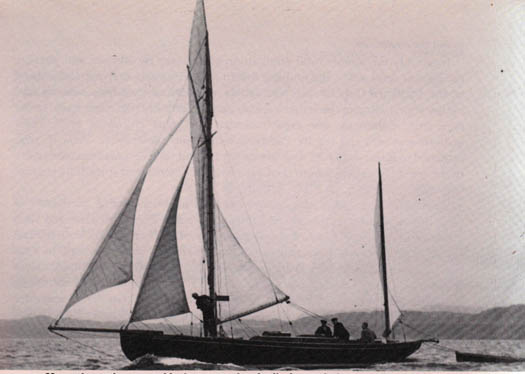
Mavis coming into port after winning the Clyde Cruising Club's annual Tobermory Race in 1938. Club rules at the time stipulated that as proper cruising yachts, the competing boats should tow their tenders throughout this race. Much effort went into designing sweet-lined dinghies.
Mavis also was overall winner of the Clyde Cruising Club's Tobermory Race in 1938. But while his own sailing was going splendidly, John Kearney was concerned at the sluggish state of sailing development in Ireland. In order to give younger people an opportunity to own their own boat, in 1932 he created the design for the 17ft Mermaid, a large clinker-built sailing dinghy which was designed to be constructed for around £180 - roughly the same price as a motorbike. The Mermaid was adopted by Dublin Bay SC, but it took a long time to gain momentum, and it wasn't until the late 1940s and early 1950s that it became the most popular class in the greater Dublin area. It is still active today with nearly 200 boats built, and more than 40 took part in its 80th Anniversary championship last summer in Skerries, the winner being Jonathan O'Rourke from the National YC,while the furthest travelled was Patrick Boardman's Thumbalina from Rush, which had started from Foynes on the Shannon Estuary, home to the most distant Mermaid fleet, and had – most impressively - sailed all the way round the south coast to Skerries to mark the 80th birthday.

The Mermaid was designed in 1932 to be built at the same price as the average motor-bike
With his retirement in 1944, John Kearney's design work came centre stage, and he was busy to the end, creating more than 20 cruising yachts in all. And life in Monkstown was pleasant. Over the door of the room where he did his design work, he'd a little motto on a brass plate: "God gives us our relatives. Thank God we can choose our friends". His close friends were all from sailing, and it was a crew member who had joined Mavis in 1946, the formidable Miss Douglas, who became his friend and housekeeper and looked after him to the end of his long and remarkable life.

John Kearney, aged 83, working at the drawings of his last design, the 54ft yawl Helen of Howth Photo: Tom Hudson

Sonia, built 1929, cruising in British Columbia, her home waters since 1958 Photo: Jeff Graham
John Kearney's entire life is in its way a great legacy, and his fine boats are his tangible memorials. They've ventured to the far corners of the world. For instance, the 30ft Evora, a lovely Bermudan yawl which he designed for building by Skinner's of Baltimore in 1936, was last reported from Darwin in Australia. The pretty Sonia of 1929 is well at home these days in British Columbia. And as for Mavis, the crème de la crème, she is currently undergoing a painstaking restoration in Maine by shipwright Ron Hawkins, who is very encouraged by the amount of original material he is able to retain.
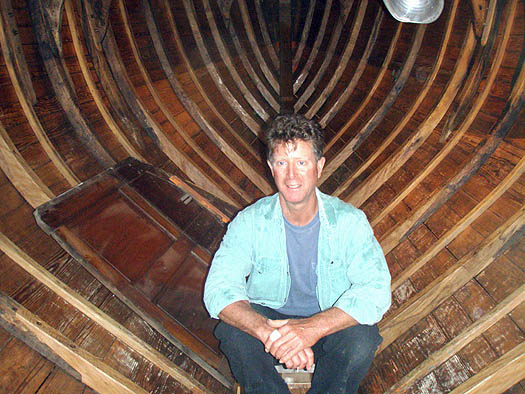
Ron Hawkins in Mavis at an early stage of his restoration project Photo: Hal Sisk

Ron Hawkins has been much encouraged by the amount of original material he has been able to retain in restoring Mavis Photo: Denise Pukas
John Kearney's first proper yacht, the 9-tonner Ainmara from 1912, has been owned for 47 years by former Round Ireland record holder Dickie Gomes of Strangford Lough. Last year, she celebrated her Centenary with a cruise to the Outer Hebrides. This year - next week in fact - she hopes to be in Dublin Bay for the Old Gaffers Association Golden Jubilee. And as it will be at Poolbeg Yacht & Boat Club, Ainmara will be back home in Ringsend for the first time in 90 years, and John Breslin Kearney will be well remembered, and celebrated too.
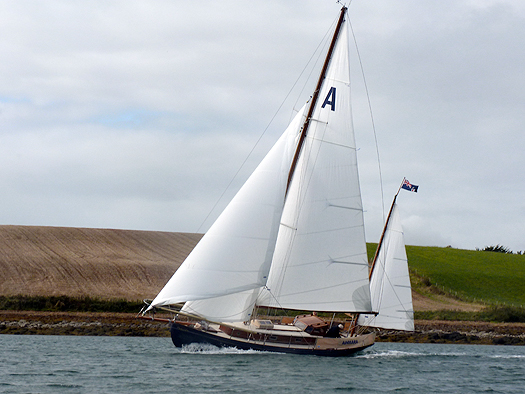
Still going strong. Dickie Gomes is the happy owner aboard Ainmara, which will be returning to Ringsend next week 101 years after she was built there to his own designs by John B Kearney Photo: W M Nixon
Comment on this story?
We'd like to hear from you! Leave a message in the box below or email William Nixon directly on [email protected]
WM Nixon's Saturday Sailing blog appears every Saturday on Afloat.ie
Follow us on twitter @afloatmagazine and on our Afloat facebook page
#FF – An initiative to introduce more sailors to one of Dublin Bay's most popular one design keelboats has been boosted with news of a fleet sponsor for the double-handed Flying fifteen (FF) class.
Kia Motors Ireland are on board with the Dublin fleet that is based almost exclusively at the National Yacht Club on Dun Laoghaire's East Pier.
The fleet currently has 20 plus boats for local DBSC racing with at least double that number for regional championships. The class plans a number of local initiatives to encourage sailors from other classes to try out the FF during midweek racing. Local sailing instructors are also being targeted as possible new recruits.
The class recently published its 2013 fixtures with two events in Northern Ireland – another FF stronghold – but the season finale is in Dun Laoghaire in the autumn and there are big plans to gather as many crews as possible for the October 5th event under the Kia motors banner.
Dun Laoghaire's National Yacht Club has a small pontoon facility with limited berthing for visiting yachts. The facility also has diesel, water, power and overnight facilities are available to cruising yachtsmen with shopping facilities being a short walk away
The club's pontoon is primarily used by its members for the short term securing of dry sailec boats prior to and after racing.
Boats dry-sailing from the platform and Club launches/RiB's have priority on the inside pontoons.
There is also a marked area for launches onto which no other vessel should berth.
Fuelling alongside may be arranged at non-racing times.
Boats may not remain overnight without the approval of the Club Boatman, unless arriving after service hours. The rate for berths are available from the club directly.
Glenans Sailing School Launch 2013 Season in Dun Laoghaire
#glenans – Minister for Transport, Tourism and Sport Leo Varadkar launched Glenans 2013 season this afternoon at the National Yacht Club in Dun Laoghaire.
As Europe's largest sailing school the French club has bases in Baltimore in West Cork and on Collanmore Island on Clew bay in County Mayo.
The Minister helped the school to launch its annual Irish sales brochure.
The Irish Glenans operation was established in 1969 and was reintegrated into its French parent in 2011.
Olympic Race Officer Jack Roy To Give Talk at Howth YC
#HYC - Next week Howth Yacht Club will host international race officer Jack Roy of the National Yacht Club, who will give an illustrated talk on his experiences in Weymouth at the London Olympics last summer.
Roy was selected by the ISAF as a technical officer, one of only seven race officers selected to supervise the UK race management teams at the Olympics.
He was also the only one of the seven who rotated through all the courses, and his talk gives a fascinating insight on how the Olympic regatta was managed.
Roy's talk takes place at the HYC on Wednesday 13 March at 8pm, and will last about 75 mins with time for questions afterwards. Admission is free, but a voluntary donation to the RNLI is expected (€5 suggested).
Annalise Murphy is Irish Sailor of the Year for 2012
#sailoroftheyear - You followed her impressive exploits right here on Afloat.ie throughout the year, and your votes counted. So it's only right that our Olympic sailing hero Annalise Murphy should receive the honour of being named Afloat.ie Sailor of the Year for 2012.
The young sailor was recognised for a remarkable 12 months of incredible achievement, capped off by her stirring performance at the London Olympics - and topped a shortlist that featured fellow Olympic challengers Peter O'Leary and David Burrows, and such up-and-coming talents as Sophie Browne, Finn Lynch and Fionn Lyden.
Murphy's simply outstanding fourth-place finish in the Laser Radial at the London Games was Ireland's best Olympic result in 30 years in any class. Despite the heartbreak of so narrowly missing out on Olympic bronze in the medal race, her accomplishment was appreciated far beyond the Irish sailing community, and raised the profile of the sport in Ireland immeasurably.
The then 22-year-old, who sails for the National Yacht Club in Dun Laoghaire, had the entire country on edge last August as she battled with what Afloat's own WM Nixon described as the "fierce challenge" of being top of the Women's Laser Radial class, in stature as well as performance.
At 6ft 1in, the woman they call 'The Irish Lever' was undoubtedly the tallest in her 41-boat fleet at London 2012, and some British yachting pundits were quick to put down her early regatta wins purely to her larger frame.
But Murphy - who headed to the Olympics with confidence after a podium finish at the Skandia Sail for Gold, and a medal at Weymouth the previous year - proved that her success was no fluke, holding the gold medal position for almost half the regatta and entering the last race in third place overall.
Facing unbelievable pressure as the regatta reached its final stages on the Nothe course in Weymouth, in tricky conditions that would spread wide the times of most club racers, it's to Murphy's estimable credit that she was able to keep so tight with the front-runners, and it was only in the last few seconds - and last few metres - that she was knocked out of the bronze position.
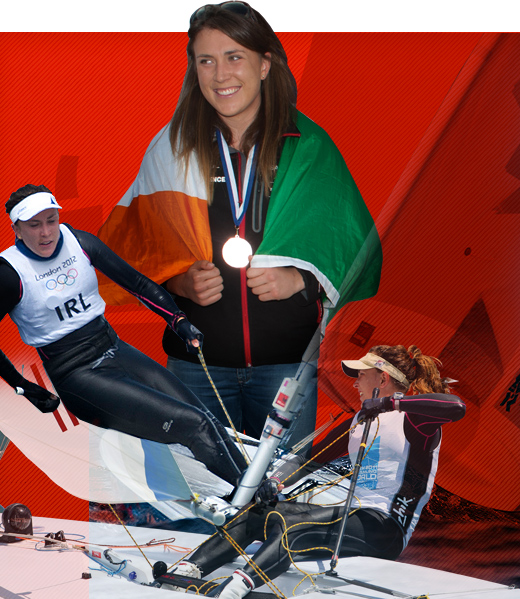
We'll never forget the tears she shed after the medal race's conclusion - the whole of Ireland shared in her heartbreak. But we also shared the belief that that was but one setback in a world-class sailing career that's only just beginning.
Considering the talented and dedicated NYC sailor and UCD student is still only 23, there's clearly plenty of sailing success awaiting in her future, and she starts 2013 on her 'Road to Rio' aiming to clinch a medal at the 2016 Olympic Games.
In spite of losing out on a podium finish at the ISAF Sailing World Cup in Miami earlier this month, the fact that she came so close - and led the charge in the early stages - proves that she can stand proudly with the elite in her class. And she'll have another chance to prove herself in the next round of the ISAF World Cup in Palma de Mallorca on 30 March.
The Sailor of the Year honour is the very least the amazing Annalise Murphy deserves for doing Ireland so proud in 2012.
Irish Yachtsmen Rescued From Stricken Vessel Off Bermuda
#Wolfhound - Four Irish yachtsmen have been rescued from a recently purchased vessel some 70–miles north of Bermuda after it suffered both power and engine failures amid stormy conditions off the northeastern United States.
The 48-foot Swan class sloop Wolfhound, purchased recently by owner/skipper Dalkeyman Alan McGettigan, had departed from Connecticut on 2 February en route to Antigua in the West Indies to compete in the RORC Caribbean 600.
As WM Nixon wrote on Afloat.ie recently, the Wolfhound was expected to eventually call Dun Laoghaire home following its Caribbean adventure.
But according to Bermuda's Bernews website, trouble began when the vessel reportedly suffered a loss of battery power due to the failure of a new inverter charger some 400 miles off the Delaware coast.
This was followed by engine failure a day after departure which left the vessel without communications or navigation systems for eight days.
Between Friday and Saturday the boat reportedly suffered two knockdowns in treacherous weather on the heels of the midwinter storm that recently battered America's northeastern states, and which led McGettigan to activate the on-board emergency beacon.
After a fruitless search by US Coast Guard aircraft, the yachtsmen were eventually located by and transferred to a passing cargo ship, Tetien Trader, which had joined the search effort.
The Wolfhound later sank some 64 miles north of Bermuda.
McGettigan's crew from the Royal Irish Yacht Club in Dun Laoghaire have been confirmed by the club's sailing manager Mark McGibney as Declan Hayes and Morgan Crowe.
Tom Mulligan of the National Yacht Club has been named locally as the fourth crew man on board.
A source close to Afloat.ie says that Hayes telephoned home from the Tetien Trader and confirmed he and the others were being "well looked after" by the Greek crew of the cargo vessel, which is due to land in Gibraltar on 19 February.
A member of the RIYC, Alan McGettigan is an experienced offshore skipper, previously sailing in areas as far afield as the Baltic Sea, the Caribbean, the South China Sea and the Mediterranean, and having competed in past Round Ireland and Dun Laoghaire to Dingle (D2D) races, most recently in the yacht Pride of Dalkey Fuji.
Dublin to Host Top Cork Dinghy Championships
#national18 – The National Yacht Club in Dun Laoghaire will be hosting the National 18 Irish dinghy sailing Championships, the first time since the mid 1960's that this exciting trapeze class will hold their Championships in Dublin.
The event will be held at the NYC from 15th & 16th June 2013.
The traditional stronghold for 18 sailing is based in Crosshaven and Monkstown in Cork where an active fleet of over 30 boats enjoys close racing on a weekly basis. They are a 3 person boat with essentially a one design GRP hull shape, with a large sail area flown on a carbon rig with one crew member using a trapeze.
They have an exhilarating performance being quicker than a Dragon upwind with gobsmacking speed downwind in any sort of a breeze. The fleet is peppered with quality sailors including former and current Olympians. Racing is lively, close and ferocious with the boats all matched with similar speed.
The hosts confidently expect a fleet of 25 boats to participate, augmented with entries also attending from some of the hotspots for 18 sailing in the UK. The fleet will have a division for Classic 18s, some of which are well over 60 years old and beautifully restored with their original clinker planking and wooden masts.
The photo of Fingal 226 below is of one of the famous rule bending so called "sticky" Parker (The famous UK builder of world beating 505s) built plywood boats constructed for Jack Flannagan of Skerries in the 1960's when the event was last held in Dublin.
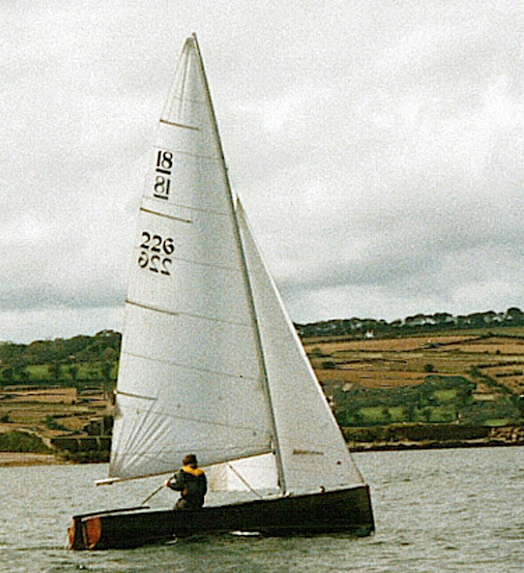
Both this boat and Finola 227 a sister ship built for Jack's brother, the famous Leo Flannigan, have been restored by enthusiastic owners to brand new condition and are still actively sailing in their original 1960's configuration. These outstanding boats being built of glued plywood planking, completely eclipsed the then commonplace traditional spruce planked boats and ultimately led to the adoption of the Proctor designed GRP smooth hull, which is still used today.
ISORA agm to Agree 2013 Offshore Race Programme for the Irish Sea
#isora – ISORA has issued its 2012 AGM Agenda plus its 2013 draft Race Schedule for the Irish Sea next year. Both are available for download below as pdf documents.
The race programme will be approved on November 17th at the National Yacht Club. Unfortunately the date clashes with the one day Irish Cruiser Racer Conference (ICRA) in Kilkenny where offshore supremo Damian Foxall will give a presentation.
The ISORA agm is followed by the Annual ISORA Prize Giving Dinner at the NYC where some of the most elegant sailing trophies including the Wolf's Head Trophy will be presented.




























